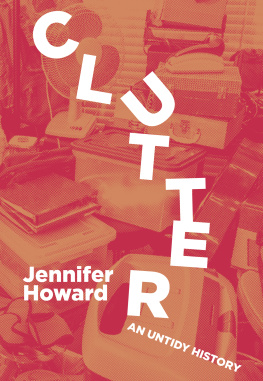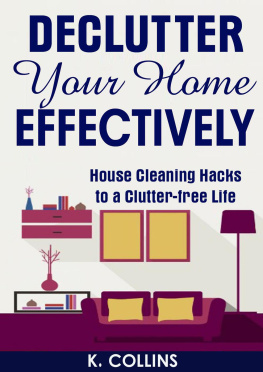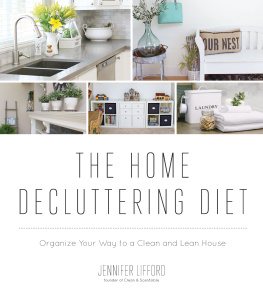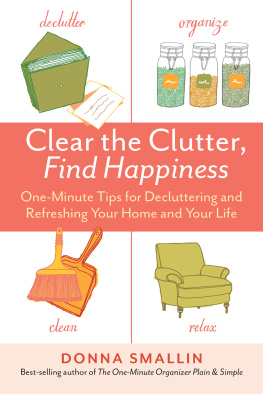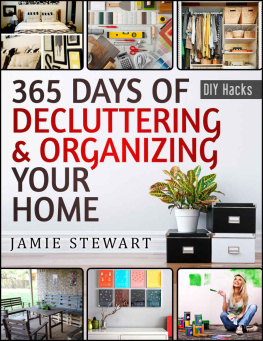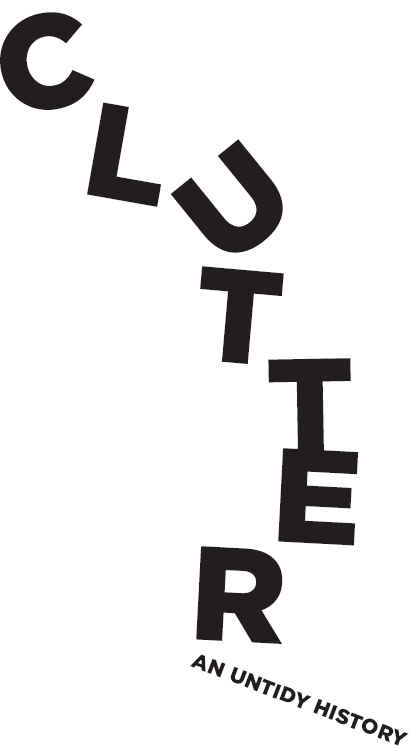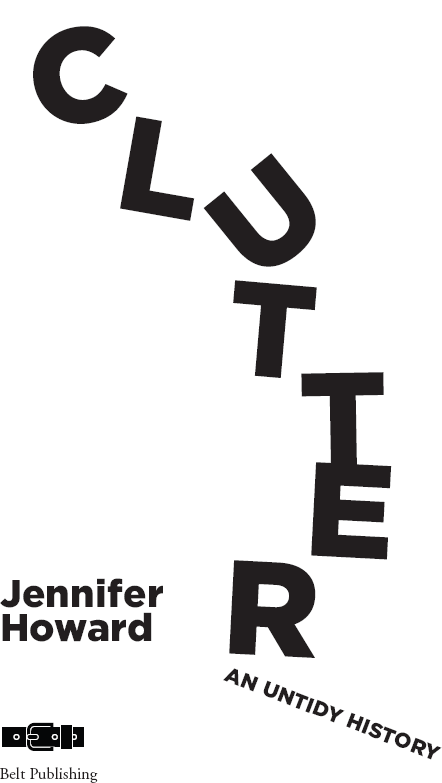
Copyright 2020 by Jennifer Howard
All rights reserved. This book or any portion thereof may not be
reproduced or used in any manner whatsoever without the express
written permission of the publisher except for the use of brief
quotations in a book review.
Printed in the United States of America
First edition 2020
1 2 3 4 5 6 7 8 9
ISBN: 978-1-948742-72-6
Belt Publishing
3143 W. 33rd Street #6
Cleveland, Ohio 44109
www.beltpublishing.com
Cover by David Wilson
Book design by Meredith Pangrace
For Mark, Lela, and Finnmy organizing principle, always
Have nothing in your houses that you do not know to be useful or believe to be beautiful.
William Morris, from The Beauty of Life,
a lecture given at the Birmingham Society
of Arts and School of Design, 1880
CONTENTS
PROLOGUE
In My Mothers House: A Personal History of Clutter
I m sitting on the floor in my mothers house, surrounded by stuff.
Its everywhereheaps and stacks and boxes and bags of it. Newspapers and junk mail sprawl across the living-room floor. Teacups hold hundreds of pennies and paper clips and rubber bands. A dozen lamps, shades off, fill the space under a harpsichord that hasnt been played in a decade.
I get up and make my way through the wreckage like a first responder assessing the damage after a hurricane. Each room presents a new scene of devastation. The coffee table in the living room is a shipwreck of mugs and glasses with brown sludge at the bottom. When I pick up one of the pizza boxes stacked next to it, crusts rattle like bones inside. Takeout Chinese food festers in Styrofoam clamshells nearby; I open one and discover the contents stinking, moving, crawling.
In the dining room, the scene of so many school-day breakfasts and holiday dinners, the table has become a graveyard of Tupperware containers and empty jars. On the screened-in porch, theres no room to walk between the bags stuffed with recycling and trash, the broken chairs and never-used roasting pans, the scratching posts for cats dead since the 1990s.
The kitchen is a health inspectors nightmare. Larvae squirm through the sludge that covers the dirty dishes filling the sink. Mouse droppings dot the countertops like sprinkles on a cupcake. When I open cabinets, I discover that the mice have gnawed into the stockpile of specialty flours and dry goods that havent been touched in years. A small corpse, victim of one the poison trays my mother has cached all over the house, lies mummified in a corner.
Squalor and chaos have infiltrated every roomupstairs, downstairs, attic, basement. No space has been left untouched. In the bedrooms, impromptu pathways thread through corridors of books and bills and weave around piles of clothes and towels and linens. To reach the shelves in the spare roommy old bedroomI have to scale mini-mountains of bagged junk and clamber over the bed, the one clear space left. I cant see the floor in my mothers office or the top of her desk. Every available surface, including the windowsills, has been taken over by detrituspill bottles, nail scissors, binder clips, chopsticks, pens, pencils, coupons, pocket change, random keys, sticks of chewing gum.
This is how my mother has been living, and it has almost killed her. And now it is my problem to deal with.
As the initial disgust and horror begin to subside, the magnitude of the task ahead sinks in. The sheer amount of stuff staggers me. The closets in the bedrooms overflow with Amalfi and Ferragamo shoes, formal gowns from four decades of artistic galas and premieres, and pantsuits for the 1980s and 90s career woman, with boxy jackets and silk scarves and gold jewelry big enough to be noticed but not large enough to be garish. My mothers friends always used to compliment her taste, tell her how elegant and pulled-together she seemed. Those friends would have been shocked at how, in the months leading up to the current crisis, she took to wearing my late stepfathers oversized jeans and shirts, because she could notor would notdo laundry for herself. At the bottom of the basement steps, I discover a mountain of dirty clothes, tossed down the stairs and left to fester.
I find emotional snares as well as mouse traps scattered throughout the house. My mother has been a mystery to me all my life, an unpredictable presence who made sure I was fed and clothed but otherwise hovered out of emotional reach. Now, as I excavate the ruins of her material life, I find clues, artifacts in situ that offer glimmers of who she might have been.
With an artists eye, she gravitated to fine and expensive things. My mother shopped to make herself feel better, to feel she had value in the world, to feel love and to express it. She excelled at giving practical gifts. She used to say that you needed the best equipment for the job. Much of the clutter I have to dig through consists of the tools of her various trades. She cant use them now.
In my old bedroom, her library fills three walls of shelves. To browse the books I have to climb over archive boxes, bags stuffed with half-finished knitting projects, an old doll carriage, a sewing machine, shoeboxes that house the extensive collection her closets cant contain. I count 500 cookbooks at least, heavy on Mediterranean cuisines. Others speak to Moms salt-of-the-earth side: books on how to pickle things, books of chutney recipes, books of local favorites from tiny New England towns. My mother used to buy cookbooks the way some people buy mystery novels or romances, always hungry for more even though she made only a handful of the recipes. Making new things wasnt the point. She hungered for the contemplation of lovely food served in elegant settings.
The contents of the other sets of shelves surprise me more. The Tolkiens and Le Guins and Lloyd Alexanders of my childhood have been displaced by a self-help library that catalogs attempts, over decades, to make sense of a disordered emotional life. Mom lived around the corner from a good public library but rarely went there to borrow something to read. Instead she propped up the self-help publishing industry seemingly by herself. She bought books on how to cope with being the adult child of an alcoholic, books on how to manage anger, books on how to make a marriage work, books on how to be a successful woman entrepreneur. Meanwhile her life, as I knew it, continued its unpredictable run: angry moods, marital strains, precarious finances. Finding her self-help library made me wonder if shed possessed more self-knowledge than I knew.
If so, it was too little, too late.
From what I know about my mother, the extreme clutter that imprisoned her was a crisis years in the making. Heres a working theory: The lacks and chaos of her childhood fed a lifelong compulsion to comfort herself with things. Clutter, like emotional chaos, has a way of running in families, passed down like curly hair or blue eyes or musical ability.
My mothers troubles with stuff began in Worcester, Massachusetts, where she grew up the oldest child of an alcoholic engineer and a housewife. She told me once that she and her younger brother and sister each got one pair of new shoes for the school year. No wonder she envied the purses and chic shoes of the wealthy girls from Shrewsbury Street. More than material things, however, she must have craved stability, something in short supply with an alcoholic father and passive, often critical mother. So she found an escape. She used her talents as a pianist and organ player to put Worcester behind her and secure a spot at Oberlins conservatory.
Next page
